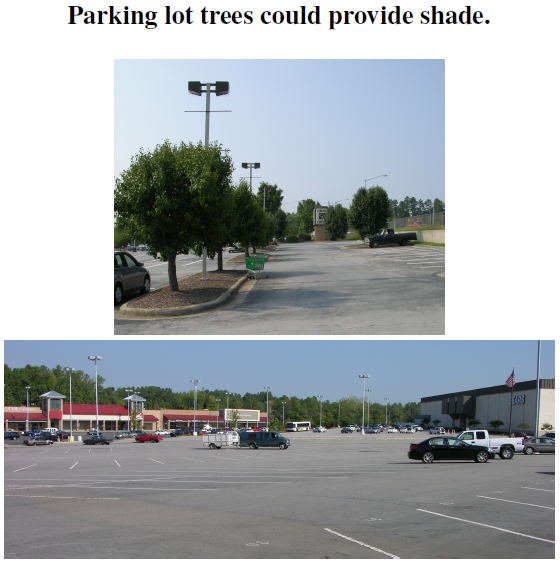2.12 Park & Shade
Figure 2.12: Two parking lots in Durham, North Carolina: The top photograph shows trees in a small mall’s parking lot. Notice that the pruning allows shade to fall primarily on the mulched surface below the tree, and the tree’s height must be limited to not interfere with the lights above. The bottom photograph shows Northgate Mall’s large parking lot with absolutely no trees. In both cases, nearly every drop of rain flows directly into stormwater systems, washing pollutants, oil, and what-not with it, and the unshaded high thermal mass surfaces contribute to the urban heat island effect.
Parking lots cover about 10% of land area in cities,[38] and these unshaded impervious surfaces help create urban heat islands. The Streets at Southpoint Mall (and its parking lot) in Figure 5.7 show up bright in the Durham County thermal image (see Figure 2.1). Durham’s newer parking lots seemingly have more potential for tree shade than older ones, yet as the top photo in Figure 2.12 shows, parking lot trees still involve several conflicting issues. First, trees aren’t pruned for optimal shade. Second, if they were, then, in this case, they would block the above lighting. Resolution of the conflict between reducing daytime lighting and increasing nighttime lighting apparently tilts toward nighttime lighting. Third, the mulched surface surrounding the trees receive most of the shade, precisely where the shade’s not really needed. Fourth, that mulched surface could absorb parking lot rainwater runoff, but the curb prevents infiltration. Finally, notice how many parking spaces in these photos go unused (see also Figure 5.7). Perhaps the developers have high hopes when they build these lots, but unused spaces cause many problems that affect everyone.
Durham is not alone in this respect. In 1983, Sacramento, California, passed an ordinance stating that 15 years after issuing a development permit, parking lots must shade 50% of their paved areas. How well did it do? Nearly 20 years later, the first results emerged from a detailed examination of 15 parking lots located in a variety of land-use areas. These lots had a combined 28.7 hectares of paved area, 6% more parking than required by ordinances. Of this, the shading ordinance required 14.4 hectares of shade, but shading covered only 4.1 hectares — just 14.4% of the paved area. Granted, the results included parking lots newer than 15 years old with young trees, yet projections of future shade provided an estimate of just 7.8 hectares of shade, or 27% of the paved surface. Furthermore, covered residential parking spaces provided 44% of the total shade, meaning that protecting a vehicle’s shine, rather than reducing the urban heat island, motivated a large part of the shade. There’s a clear difference between passing Planning Department regulations and subsequent implementation and enforcement of those regulations.
Regarding costs and benefits, this Sacramento study calculated annual benefits of $19.20 per tree, and if Sacramento met the required 50% shading level, citywide annual benefits would total $4 million. Yet, even the existing trees in these parking lots needed maintenance. Within the 15 lots examined, 42 trees needed removal, 435 staking adjustments, 41 trimming, and 620 other types of care. Projecting the costs of these unmet needs to the entire city led to a cost of $1.1 million for the trees providing 9% cover. A cost–benefit analysis demonstrated an estimated $20 million tree-planting cost to achieve 50% cover, with a payback time of 10 years.
————————-
[38]McPherson (2001) examined parking lot shading by trees in Sacramento, California, and presents ideas for redesigning parking lots for enhanced shading.
